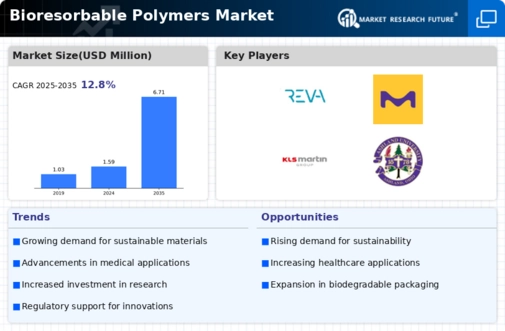Market Analysis
In-depth Analysis of Bioresorbable Polymers Market Industry Landscape
Revolutionizing Drug Delivery: Bioresorbable Polymers' Impact Unleashed
The realm of drug delivery technology has undergone a profound transformation, thanks to the pivotal role played by polymers in enabling controlled release of therapeutic agents. This entails ensuring consistent dosages over prolonged periods, facilitating cyclic dosing, and delivering both hydrophilic and hydrophobic medicines through various mechanisms. From its initial stages employing commonplace materials, the field has evolved dramatically, with the rational design of polymers emerging as the bedrock for contemporary advancements in drug delivery. Custom-tailored polymers designed to exert specific biological activities have become instrumental in pushing the boundaries of drug delivery.
Bioresorbable polymers, in particular, have emerged as a linchpin in this journey, providing controlled release to designated sites, stability to inherently unstable molecules (such as proteins), and the ability to modify surfaces with ligands for discreet and targeted drug delivery within the human body. The significance of polymers in therapies and nanomedicines cannot be overstated, with polymeric nanoparticles standing out as solid, mostly spherical structures derived from organic or synthetic polymers. These nanoparticles find profound application in drug delivery, serving as carriers for a diverse range of substances, including hydrophilic and hydrophobic drugs, vaccines, peptides, and biological macromolecules.
Among the biodegradable polymers dominating the production of polymeric nanoparticles, various grades of poly(lactide-co-glycolide) and poly(lactide) copolymers have proven most effective. The multifaceted properties of bioresorbable polymers position them as pivotal elements in novel drug delivery systems and nanomedicines, propelling the global bioresorbable polymers market forward.
Several factors converge to steer this market trajectory, notably the escalating number of surgical interventions, heightened demand for biocompatible medical devices, a surge in drug delivery applications, and favorable reimbursement scenarios. Resorbable polymers play a crucial role in pharmaceutical coatings, particularly for capsules, facilitating drug absorption into the body without adverse effects. This, in turn, streamlines the delivery of medication in precise amounts without the need for recurrent, needle-centric procedures, enhancing patient comfort. Once the objective of drug delivery is fulfilled, these polymers are naturally absorbed by the body.
The cost-effectiveness of bioresorbable polymers relative to conventional counterparts, coupled with the imperative for least invasiveness, further propels their adoption. The non-toxic nature of bioresorbable polymers aligns seamlessly with the increasing emphasis on safety and biocompatibility in the healthcare landscape, contributing to the forecasted growth of the global market. As drug delivery technologies continue to evolve, bioresorbable polymers are poised to play an increasingly pivotal role, offering innovative solutions that prioritize patient well-being and treatment efficacy.







Leave a Comment